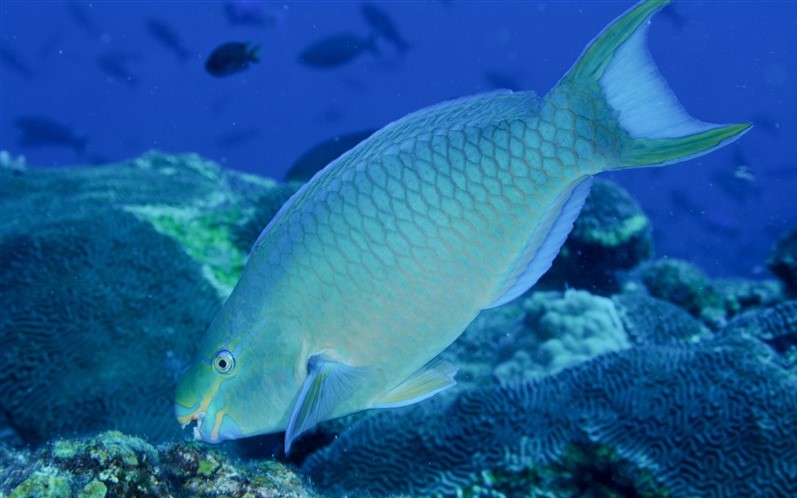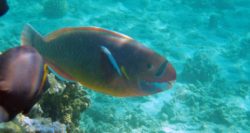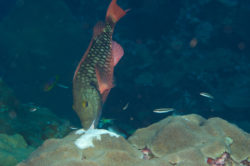
Sea Wonder: Parrotfish

Photo: G. P. Schmahl/NOAA
Parrotfish – named for their vibrant colors and fused teeth that form beak-like plates on their mouths – are popular fish among divers. But they’re more than beautiful – these grazers help coral reefs stay healthy by feeding on algal overgrowth and even chewing on older coral pieces, including the hard skeleton, to make room for new growth. Because their digestive systems can break down the calcium carbonate in coral skeletons, parrotfish poop as much as 2,000 pounds of sand each year, providing the fine, white sand we all love for the seafloor and beaches alike!
Description
More than 80 species of parrotfish inhabit the world’s ocean, each unique in its physical appearance. Common to most species are brightly colored, thick scales (scales that, in some species, are strong enough to block a spear) and fused teeth that form plates that resemble a parrot’s beak located in or covering the fish’s mouth. Parrotfish change colors based on age, diet, gender, and other factors, which means males and females generally differ in appearance.
Depending on the species and where they live, adults be as small as a foot in length or more than four feet long. Some species have unique features that help them survive in their ecological niche, like the bumphead parrotfish, the world’s largest parrotfish species with (you guessed it!) a large bump on its head used for mating behavior.
Diet & Habitat

Photo: G. P. Schmahl/NOAA
Parrotfish live in tropical and subtropical parts of the world’s ocean and feed on algae, detritus, and dead pieces of coral. They occupy shallow waters near coral reefs all over the world. In the National Marine Sanctuary System, we see parrotfish in and near Flower Garden Banks in the Gulf of Mexico, Florida Keys, Hawaiian Islands Humpback Whale and National Marine Sanctuary of American Samoa in the Pacific.
Their strong, beak-like plates allow for both precision grazing of algal growth or chomping off large pieces of coral that are dead or unhealthy. Parrotfish teeth plates are some of the strongest teeth in the world, which wear down and regrow over time due to their constant grazing. In the back of their throats, most species have a second set of teeth that help them chew.
Parrotfish are active during the day and at night, they burrow in the sand or hide in crevices to rest. Some species even cover themselves in a clear mucous membrane at night to mask their scent and protect them from predators.
Life History
Parrotfish are important parts of reef ecosystems even though they eat coral. This is because they clean algal overgrowth off of coral colonies, which allows the algae that live inside the coral to get more sunlight and make more food through photosynthesis. When they eat coral, they usually break off sections that are dead or unhealthy, which can prevent the spread of disease in the colony or just make room for new growth. In fact, one of the most important things we can do to keep coral reefs healthy around the world is to make sure parrotfish populations are adequately protected.
Parrotfish have the unique ability to change their sex throughout their lifetimes. This occurs because of regular hormonal changes in the fish. Not all fish change sex, though; it depends on species, individuals, and environmental conditions.
Threats & Conservation
Parrotfish depend on healthy coral reef ecosystems to survive and coral reef systems depend on parrotfish to help them survive. This means parrotfish are vulnerable to the same threats facing coral reefs worldwide: global climate change, ocean acidification, pollution, and marine debris. Since some species of parrotfish are considered delicacies, their populations are also at risk of being overfished.

Photo: G. P. Schmahl/NOAA
